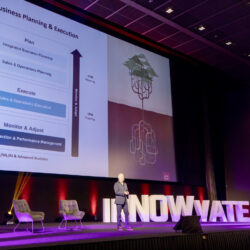Passionate plea for integration of financial planning and supply chain planning

How on earth can we expect supply chain agility when each department clings to its own planning processes? During Supply Chain Media’s S&OP Flavour Day, Bram Desmet issued a passionate plea for integrating financial planning and supply chain planning processes. “They are already three-quarters identical,” argued the Vlerick Business School professor. Food giant Mars Wrigley is already making good progress by implementing enterprise planning.
By Marcel te Lindert
Virtually all supply chain professionals who implement sales & operations planning (S&OP) are familiar with Gartner’s five-stage maturity model. Many S&OP managers are happy just to reach Stage 3, and some S&OP experts claim that plenty of companies don’t even need Stage 4. However, according to professor Bram Desmet (pictured) the minimum requirement is Stage 5. “One condition for this stage is that you have a connection with your key customers and suppliers. Explain to me how you want to manage your supply chain if you don’t, especially now that that customer demand has become less predictable.”
Stage 5 is also about bringing the financial aspect into the decision-making process. “In today’s volatile times, how can you survive if you make decisions based on product quantities rather than the financial value they represent? For some reason, we still think that Stage 3 or 4 is good enough. That may have been true 10 or 15 years ago, but not anymore,” said Desmet, who is currently working on his third book, about the link between strategy, supply chain and finance.
The opposite of agility
During S&OP Flavour Day, Desmet even went so far as to question whether Stage 5 is good enough. “To answer that question, we have to look at the essence of what S&OP actually is: a cross-functional process that connects the silos within a company. It’s not the systems and the data that cause the headaches, but the people. We have to get people from different departments to work together, even when they can’t be bothered and don’t see the point.”
Desmet showed a visualization of different planning processes and systems in different departments. That results in an organization made up of independently operating silos. “If you don’t integrate those planning processes, you get the opposite of agility. You can only be responsive if information flows through all the silos of the organization quickly. The aim of S&OP is to interconnect those silos.”
Integrating financial planning and supply chain planning
Desmet supports a totally different approach based on the full integration of financial planning and supply chain planning. “I no longer support the idea that we should have separate processes for this. After all, these planning processes are three-quarters identical. First of all, the current approach involves duplicated effort to do both the financial planning and the supply chain planning. Then it takes extra effort to reconnect the two. This is neither particularly efficient nor effective, because Finance lacks the detailed information for proper analysis and Supply Chain lacks the financial information to make the right decisions.”
 During the debate at the end of the day, Desmet asked three experienced supply chain professionals for their opinions on the integration of financial planning and supply chain planning. Ariane Longpré (pictured) was strongly in favour of it: “The world would be a better place,” stated the Director Global Planning at detergent manufacturer Henkel. “It’s all about speed and efficiency. The belief that you can operate alone shows a lack of modesty. There’s so much uncertainty in the world that we need everyone to form some kind of picture of the future, and that requires cross-functional collaboration.”
During the debate at the end of the day, Desmet asked three experienced supply chain professionals for their opinions on the integration of financial planning and supply chain planning. Ariane Longpré (pictured) was strongly in favour of it: “The world would be a better place,” stated the Director Global Planning at detergent manufacturer Henkel. “It’s all about speed and efficiency. The belief that you can operate alone shows a lack of modesty. There’s so much uncertainty in the world that we need everyone to form some kind of picture of the future, and that requires cross-functional collaboration.”
Enterprise planning
 Annika Goudswaard (pictured) from Adama also agreed with Desmet’s vision. In fact, the producer of crop protection solutions has already taken some steps towards integrating financial planning and supply chain planning. “When it comes to Sales & Operations Execution (S&OE), i.e. short-term decision-making, the discussion is led by Finance and its dashboards. When it comes to medium-term decision-making, we take the lead and coordinate with Finance on how to translate predicted and planned volumes into financial value.”
Annika Goudswaard (pictured) from Adama also agreed with Desmet’s vision. In fact, the producer of crop protection solutions has already taken some steps towards integrating financial planning and supply chain planning. “When it comes to Sales & Operations Execution (S&OE), i.e. short-term decision-making, the discussion is led by Finance and its dashboards. When it comes to medium-term decision-making, we take the lead and coordinate with Finance on how to translate predicted and planned volumes into financial value.”
Edith van Erp (pictured), EU Market Collaboration Director at Mars Wrigley, suggested referring to the concept as ‘enterprise planning’, which is the term used within her company. “We deliberately don’t talk about supply chain planning, but enterprise planning instead,” she stated. “We started implementing it three and a half years ago, when we realized we needed to become more intelligent, more integrated and more agile. We developed a new operating model, set up the necessary organizational structure and then looked at systems.”
Scenario planning
 Part of the new organizational structure is an end-to-end integrated planning team. “That means all the demand planners in the various markets report directly to me. We stopped asking Sales to do the planning because we found that salespeople can’t plan; it’s not their job and not part of their skillset. Supply chain professionals are much better at planning. We make a statistical forecast which is subsequently enriched with information from Sales or Marketing, for example. When we have the complete picture, we convert the volumes into cash terms. That’s the figure that is signed off by Sales and is also used by Finance.”
Part of the new organizational structure is an end-to-end integrated planning team. “That means all the demand planners in the various markets report directly to me. We stopped asking Sales to do the planning because we found that salespeople can’t plan; it’s not their job and not part of their skillset. Supply chain professionals are much better at planning. We make a statistical forecast which is subsequently enriched with information from Sales or Marketing, for example. When we have the complete picture, we convert the volumes into cash terms. That’s the figure that is signed off by Sales and is also used by Finance.”
Mars has implemented scenario planning too. If Sales can secure a big deal with a customer, the supply chain planner can run real-time scenarios to analyse the impact of that order. “If everyone agrees that the order is a good idea, we can adjust the plan immediately,” said Van Erp. She described the implementation of enterprise planning as successful, largely due to the broad support within the organization: “This was not a supply chain project, but a project involving the entire company.”










